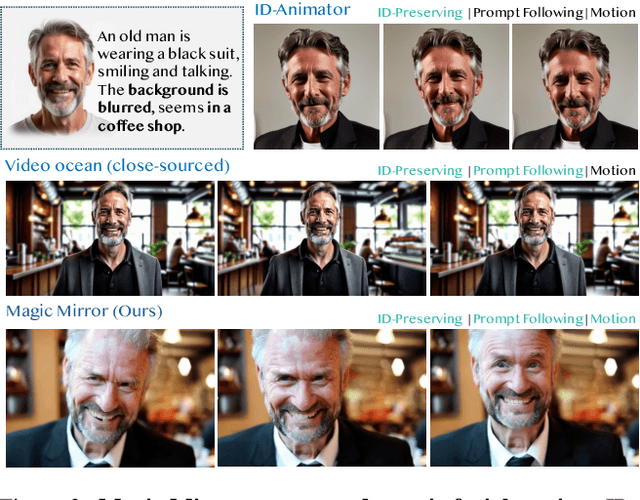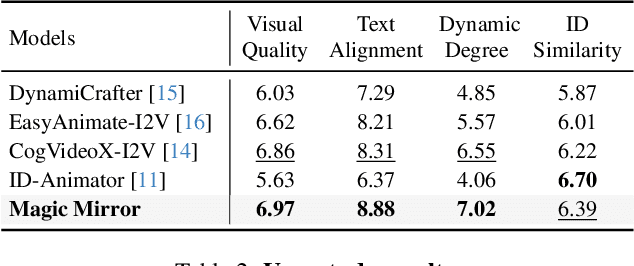Yuechen Zhang
Magic Mirror: ID-Preserved Video Generation in Video Diffusion Transformers
Jan 07, 2025



Abstract:We present Magic Mirror, a framework for generating identity-preserved videos with cinematic-level quality and dynamic motion. While recent advances in video diffusion models have shown impressive capabilities in text-to-video generation, maintaining consistent identity while producing natural motion remains challenging. Previous methods either require person-specific fine-tuning or struggle to balance identity preservation with motion diversity. Built upon Video Diffusion Transformers, our method introduces three key components: (1) a dual-branch facial feature extractor that captures both identity and structural features, (2) a lightweight cross-modal adapter with Conditioned Adaptive Normalization for efficient identity integration, and (3) a two-stage training strategy combining synthetic identity pairs with video data. Extensive experiments demonstrate that Magic Mirror effectively balances identity consistency with natural motion, outperforming existing methods across multiple metrics while requiring minimal parameters added. The code and model will be made publicly available at: https://github.com/dvlab-research/MagicMirror/
DreamOmni: Unified Image Generation and Editing
Dec 22, 2024Abstract:Currently, the success of large language models (LLMs) illustrates that a unified multitasking approach can significantly enhance model usability, streamline deployment, and foster synergistic benefits across different tasks. However, in computer vision, while text-to-image (T2I) models have significantly improved generation quality through scaling up, their framework design did not initially consider how to unify with downstream tasks, such as various types of editing. To address this, we introduce DreamOmni, a unified model for image generation and editing. We begin by analyzing existing frameworks and the requirements of downstream tasks, proposing a unified framework that integrates both T2I models and various editing tasks. Furthermore, another key challenge is the efficient creation of high-quality editing data, particularly for instruction-based and drag-based editing. To this end, we develop a synthetic data pipeline using sticker-like elements to synthesize accurate, high-quality datasets efficiently, which enables editing data scaling up for unified model training. For training, DreamOmni jointly trains T2I generation and downstream tasks. T2I training enhances the model's understanding of specific concepts and improves generation quality, while editing training helps the model grasp the nuances of the editing task. This collaboration significantly boosts editing performance. Extensive experiments confirm the effectiveness of DreamOmni. The code and model will be released.
Lyra: An Efficient and Speech-Centric Framework for Omni-Cognition
Dec 12, 2024



Abstract:As Multi-modal Large Language Models (MLLMs) evolve, expanding beyond single-domain capabilities is essential to meet the demands for more versatile and efficient AI. However, previous omni-models have insufficiently explored speech, neglecting its integration with multi-modality. We introduce Lyra, an efficient MLLM that enhances multimodal abilities, including advanced long-speech comprehension, sound understanding, cross-modality efficiency, and seamless speech interaction. To achieve efficiency and speech-centric capabilities, Lyra employs three strategies: (1) leveraging existing open-source large models and a proposed multi-modality LoRA to reduce training costs and data requirements; (2) using a latent multi-modality regularizer and extractor to strengthen the relationship between speech and other modalities, thereby enhancing model performance; and (3) constructing a high-quality, extensive dataset that includes 1.5M multi-modal (language, vision, audio) data samples and 12K long speech samples, enabling Lyra to handle complex long speech inputs and achieve more robust omni-cognition. Compared to other omni-methods, Lyra achieves state-of-the-art performance on various vision-language, vision-speech, and speech-language benchmarks, while also using fewer computational resources and less training data.
ControlNeXt: Powerful and Efficient Control for Image and Video Generation
Aug 15, 2024



Abstract:Diffusion models have demonstrated remarkable and robust abilities in both image and video generation. To achieve greater control over generated results, researchers introduce additional architectures, such as ControlNet, Adapters and ReferenceNet, to integrate conditioning controls. However, current controllable generation methods often require substantial additional computational resources, especially for video generation, and face challenges in training or exhibit weak control. In this paper, we propose ControlNeXt: a powerful and efficient method for controllable image and video generation. We first design a more straightforward and efficient architecture, replacing heavy additional branches with minimal additional cost compared to the base model. Such a concise structure also allows our method to seamlessly integrate with other LoRA weights, enabling style alteration without the need for additional training. As for training, we reduce up to 90% of learnable parameters compared to the alternatives. Furthermore, we propose another method called Cross Normalization (CN) as a replacement for Zero-Convolution' to achieve fast and stable training convergence. We have conducted various experiments with different base models across images and videos, demonstrating the robustness of our method.
ResMaster: Mastering High-Resolution Image Generation via Structural and Fine-Grained Guidance
Jun 24, 2024



Abstract:Diffusion models excel at producing high-quality images; however, scaling to higher resolutions, such as 4K, often results in over-smoothed content, structural distortions, and repetitive patterns. To this end, we introduce ResMaster, a novel, training-free method that empowers resolution-limited diffusion models to generate high-quality images beyond resolution restrictions. Specifically, ResMaster leverages a low-resolution reference image created by a pre-trained diffusion model to provide structural and fine-grained guidance for crafting high-resolution images on a patch-by-patch basis. To ensure a coherent global structure, ResMaster meticulously aligns the low-frequency components of high-resolution patches with the low-resolution reference at each denoising step. For fine-grained guidance, tailored image prompts based on the low-resolution reference and enriched textual prompts produced by a vision-language model are incorporated. This approach could significantly mitigate local pattern distortions and improve detail refinement. Extensive experiments validate that ResMaster sets a new benchmark for high-resolution image generation and demonstrates promising efficiency. The project page is https://shuweis.github.io/ResMaster .
Mini-Gemini: Mining the Potential of Multi-modality Vision Language Models
Mar 27, 2024



Abstract:In this work, we introduce Mini-Gemini, a simple and effective framework enhancing multi-modality Vision Language Models (VLMs). Despite the advancements in VLMs facilitating basic visual dialog and reasoning, a performance gap persists compared to advanced models like GPT-4 and Gemini. We try to narrow the gap by mining the potential of VLMs for better performance and any-to-any workflow from three aspects, i.e., high-resolution visual tokens, high-quality data, and VLM-guided generation. To enhance visual tokens, we propose to utilize an additional visual encoder for high-resolution refinement without increasing the visual token count. We further construct a high-quality dataset that promotes precise image comprehension and reasoning-based generation, expanding the operational scope of current VLMs. In general, Mini-Gemini further mines the potential of VLMs and empowers current frameworks with image understanding, reasoning, and generation simultaneously. Mini-Gemini supports a series of dense and MoE Large Language Models (LLMs) from 2B to 34B. It is demonstrated to achieve leading performance in several zero-shot benchmarks and even surpasses the developed private models. Code and models are available at https://github.com/dvlab-research/MiniGemini.
Prompt Highlighter: Interactive Control for Multi-Modal LLMs
Dec 07, 2023



Abstract:This study targets a critical aspect of multi-modal LLMs' (LLMs&VLMs) inference: explicit controllable text generation. Multi-modal LLMs empower multi-modality understanding with the capability of semantic generation yet bring less explainability and heavier reliance on prompt contents due to their autoregressive generative nature. While manipulating prompt formats could improve outputs, designing specific and precise prompts per task can be challenging and ineffective. To tackle this issue, we introduce a novel inference method, Prompt Highlighter, which enables users to highlight specific prompt spans to interactively control the focus during generation. Motivated by the classifier-free diffusion guidance, we form regular and unconditional context pairs based on highlighted tokens, demonstrating that the autoregressive generation in models can be guided in a classifier-free way. Notably, we find that, during inference, guiding the models with highlighted tokens through the attention weights leads to more desired outputs. Our approach is compatible with current LLMs and VLMs, achieving impressive customized generation results without training. Experiments confirm its effectiveness in focusing on input contexts and generating reliable content. Without tuning on LLaVA-v1.5, our method secured 69.5 in the MMBench test and 1552.5 in MME-perception. The code is available at: https://github.com/dvlab-research/Prompt-Highlighter/
Make-Your-Video: Customized Video Generation Using Textual and Structural Guidance
Jun 01, 2023



Abstract:Creating a vivid video from the event or scenario in our imagination is a truly fascinating experience. Recent advancements in text-to-video synthesis have unveiled the potential to achieve this with prompts only. While text is convenient in conveying the overall scene context, it may be insufficient to control precisely. In this paper, we explore customized video generation by utilizing text as context description and motion structure (e.g. frame-wise depth) as concrete guidance. Our method, dubbed Make-Your-Video, involves joint-conditional video generation using a Latent Diffusion Model that is pre-trained for still image synthesis and then promoted for video generation with the introduction of temporal modules. This two-stage learning scheme not only reduces the computing resources required, but also improves the performance by transferring the rich concepts available in image datasets solely into video generation. Moreover, we use a simple yet effective causal attention mask strategy to enable longer video synthesis, which mitigates the potential quality degradation effectively. Experimental results show the superiority of our method over existing baselines, particularly in terms of temporal coherence and fidelity to users' guidance. In addition, our model enables several intriguing applications that demonstrate potential for practical usage.
Real-World Image Variation by Aligning Diffusion Inversion Chain
May 30, 2023Abstract:Recent diffusion model advancements have enabled high-fidelity images to be generated using text prompts. However, a domain gap exists between generated images and real-world images, which poses a challenge in generating high-quality variations of real-world images. Our investigation uncovers that this domain gap originates from a latents' distribution gap in different diffusion processes. To address this issue, we propose a novel inference pipeline called Real-world Image Variation by ALignment (RIVAL) that utilizes diffusion models to generate image variations from a single image exemplar. Our pipeline enhances the generation quality of image variations by aligning the image generation process to the source image's inversion chain. Specifically, we demonstrate that step-wise latent distribution alignment is essential for generating high-quality variations. To attain this, we design a cross-image self-attention injection for feature interaction and a step-wise distribution normalization to align the latent features. Incorporating these alignment processes into a diffusion model allows RIVAL to generate high-quality image variations without further parameter optimization. Our experimental results demonstrate that our proposed approach outperforms existing methods with respect to semantic-condition similarity and perceptual quality. Furthermore, this generalized inference pipeline can be easily applied to other diffusion-based generation tasks, such as image-conditioned text-to-image generation and example-based image inpainting.
Video-P2P: Video Editing with Cross-attention Control
Mar 08, 2023Abstract:This paper presents Video-P2P, a novel framework for real-world video editing with cross-attention control. While attention control has proven effective for image editing with pre-trained image generation models, there are currently no large-scale video generation models publicly available. Video-P2P addresses this limitation by adapting an image generation diffusion model to complete various video editing tasks. Specifically, we propose to first tune a Text-to-Set (T2S) model to complete an approximate inversion and then optimize a shared unconditional embedding to achieve accurate video inversion with a small memory cost. For attention control, we introduce a novel decoupled-guidance strategy, which uses different guidance strategies for the source and target prompts. The optimized unconditional embedding for the source prompt improves reconstruction ability, while an initialized unconditional embedding for the target prompt enhances editability. Incorporating the attention maps of these two branches enables detailed editing. These technical designs enable various text-driven editing applications, including word swap, prompt refinement, and attention re-weighting. Video-P2P works well on real-world videos for generating new characters while optimally preserving their original poses and scenes. It significantly outperforms previous approaches.
 Add to Chrome
Add to Chrome Add to Firefox
Add to Firefox Add to Edge
Add to Edge